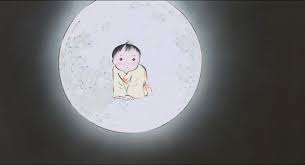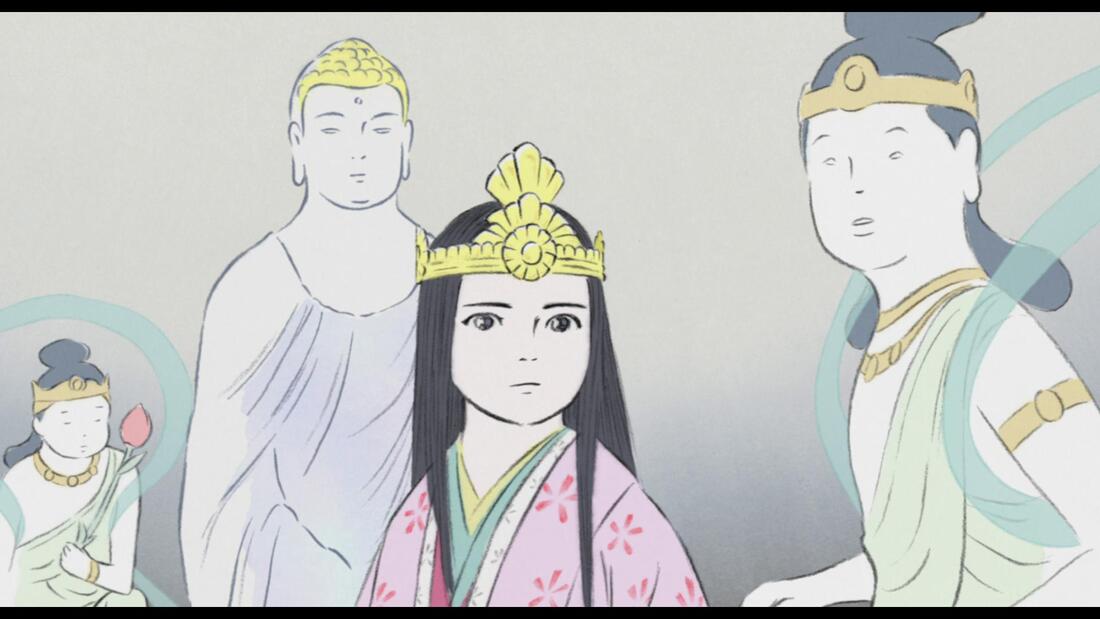 In Pureland Buddhism (Jodo in Japanese), Amida Buddha, a monk who reached Buddhahood and earned his own pureland through his merit, is seen as a kind, compassionate figure who invites all who chant: “Namu Amida Butsu” (Hail to the Amida Buddha) to live in his Western Paradise after they die. His is often portrayed in a Raigo (“Welcoming approach”) which is an image (painting or sculpture) of him descending to earth to welcome the souls to the Western paradise. At the Ho-o-do (Phoenix Hall), a part of what was once a villa of the Fujiwara clan near Kyoto, Japan, images adorn walls and a door, showing scenes of the Raigo. This building was constructed in the 1000’s during the Heian period (784-1183 CE). The text in the book Art Beyond the West describes the imagery: They include monks and bodhisattvas on clouds, and an orchestra-chorus of music-making and dancing Buddhist beings dramatizing the arrival of the Buddha. Together the many raigos, concentrated in this small, intimate space that was once a home, dramatize the compassion and glory of the Buddha in this popular sect of Buddhism (P. 164, Chapter 5). At the end of the film, The Tale of the Princess Kaguya, however, the almost identical image is interpreted in a vastly different way. While Buddha appears both kind and compassionate, and his many attendants exhibit a beautiful, peaceful air, they are coming to take the title character, Kaguya back to the moon, from which she had previously left after hearing rumors of earth and the emotions living there evoke. Kaguya, who has spent almost a decade on earth (though she ages faster) has come to love it and it’s natural world and people. When she is being taken back to the moon, her adoptive parents, as well as many people she knew and some she didn’t watch her leave and express a grief at her going. She too had become desperate when she realized she would have to return, saying that she did not want to forget the earth and the places and people there, and the emotions they had inspired. This is a stark contrast to the emphasized joy and celebration of Pureland Buddhism and seems to question the idea that there should be a place of greater joy and beauty for us than the earth on which we are born, live our lives, and die. It also seems to suggest that if the earth is awe-inspiring and worthy of contemplation, as many Japanese practices say it is, then the it should not be abandoned in hope of finding greater understanding and happiness elsewhere.  While the film The Tale of Princess Kaguya does not have to be viewed in a scholarly or even analyzed way, such an approach does present some fascinating and helpful connections. For instance, the film is set in either the Heian (784-1183) or Kamakura (1185-1333) period, which for those of us with a bit of (art) history knowledge, will quickly become clear. However, one of the most important things about watching any Studio Ghibli film, and specifically this one, is to enjoy yourself a little, to laugh at the simple charming moment, or to just let the beauty and sorrows and longing and hope present in any of these films catch you up a little and let you see a new way to look at the world, a way that is both distinctly Japanese, and broadly human. -Bee
0 Comments
Your comment will be posted after it is approved.
Leave a Reply. |
AuthorEach of the Silverfists take turns sharing their thoughts about illustration found in graphic novels, games, album art, and more... Archives
October 2023
Categories |


 RSS Feed
RSS Feed